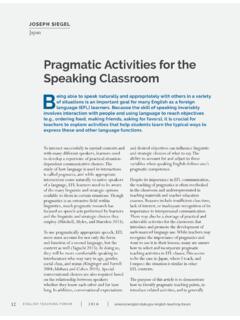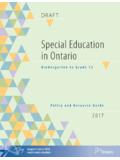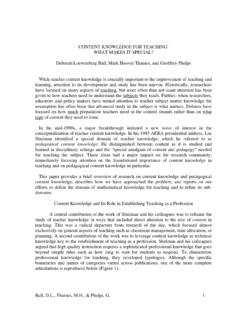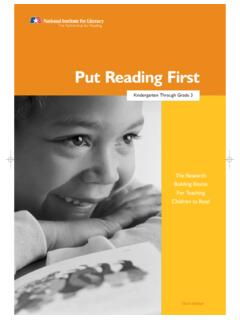Transcription of A Review of the Literature on English as a Second Language ...
1 A Review of the Literature on English as a Second Language (ESL) Issues The Language Research Centre University of Calgary Prepared by: John Archibald, Kara Bashutski, Yan Guo, Carly Jaques, Carla Johnson, Michelle McPherson, Hetty Roessingh and Christine Shea 2008 ALBERTA EDUCATION CATALOGUING IN PUBLICATION DATA A Review of the Literature on English as a Second Language (ESL) issues / prepared by John Archibald .. [et al.] ISBN 978 0 7785 7495 8 1. English Language Study and teaching Foreign speakers Bibliography.
2 2. English Language Study and teaching as a Second Language Bibliography. I. Archibald, John. II. University of Calgary. Language Research Centre. III. Alberta. Alberta Education. A333 2008 Questions or concerns regarding this document can be addressed to the Director, Curriculum Branch, Alberta Education. Telephone 780 427 2984. To be connected toll free inside Alberta, dial 310 0000. Copyright 2008, the Crown in Right of Alberta, as represented by the Minister of Education.
3 Alberta Education, Curriculum Branch, 44 Capital Boulevard, 10044 108 Street, Edmonton, Alberta, Canada, T5J 5E6. Every effort has been made to provide proper acknowledgement of original sources. If cases are identified where this has not been done, please notify Alberta Education so appropriate corrective action can be taken. Permission is given by the copyright owner to reproduce this document for educational purposes and on a nonprofit basis, with the exception of materials cited for which Alberta Education does not own copyright.
4 A Review of the Literature on ESL Issues / iii Alberta Education, Alberta, Canada 2008 Table of Contents Preamble .. v Part I: Content and Curriculum for ESL Students .. 1 Part II: How Can Schools Best Identify ESL Students with Special Education Needs, Diagnose Their Learning Needs and Provide Effective Programming? .. 25 Introduction .. 25 Intelligence (IQ) Tests .. 26 Over-representation of ESL Learners in Special Education .. 27 Under-representation of ESL Learners in Special Education.
5 30 Systemic Barriers to Assessment .. 31 Linguistic Considerations for Assessment .. 34 Bilingual Assessment .. 35 Culture-fair Models of Assessment .. 36 Culturally Responsive teaching .. 38 Cultural Sensitivity Training for Teachers .. 41 instructional Strategies for New Teachers .. 44 Curriculum Reform .. 46 Early Intervention for ESL Students at Risk for Reading and Learning Difficulties .. 46 Explicit Reading Instruction Strategies .. 47 Parental Involvement: Empowering Teachers and Parents.
6 48 Affective Factors .. 52 A Sociocultural View of Learning .. 52 Dyslexia .. 53 Visual Impairments/Hard of Hearing .. 55 Part III: ESL Students with Limited First Language (L1) Literacy Skills .. 57 References .. 67 iv / A Review of the Literature on ESL Issues 2008 Alberta Education, Alberta, Canada A Review of the Literature on ESL Issues / v Alberta Education, Alberta, Canada 2008 Preamble The Language Research Centre at the University of Calgary was contracted by Alberta Education to produce an annotated bibliography on diverse aspects of education related to English as a Second Language (ESL) students.
7 Part I deals with best practices when it comes to delivering content and curriculum in the ESL classroom, Part II deals with meeting the needs of students with special needs in the ESL community, and Part III addresses the question of how best to serve ESL students who have limited literacy skills in their first Language . A Review of the Literature on ESL Issues / 1 Alberta Education, Alberta, Canada 2008 PART I: Content and Curriculum for ESL Students Introduction The following is a Review of the Literature that supports content-based Language learning.
8 The articles and books reviewed here cover recent Literature as well as a number of key contributions that date as far back as the late 1980s. There are many commonalities between the earlier works and those of more recent origins since the authors grapple with similar concepts. These early inquiries into content-based Language learning offer insights and discuss educational benefits in the areas of learning strategies, thematic teaching , sheltered instruction, collaborative learning, use of comprehensible input and concept development.
9 The foundational Literature is preoccupied with identifying areas of interest, while the more contemporary resources approach these issues more pragmatically. More recent texts read as how-to manuals for the classroom teacher. A number of additional themes emerge within this body of Literature . Common instructional strategies are repeatedly cited as sound practice for the content-based Language learning classroom. The development and use of native Language is seen as advantageous to both learner and teacher.
10 The learner builds cognitive resources and gains cultural knowledge, while the teacher is able to activate prior learning and build background knowledge. Under the umbrella of comprehensible input, the use of appropriate materials and visuals, modified Language and scaffolding are discussed. While commonalities do emerge, the field is divided regarding direct instruction. There are two distinct camps, where one calls for direct instruction in all aspects of Language , , vocabulary, structure and concepts, and the other posits that learners will acquire the Language when actively engaged in learning the content.














